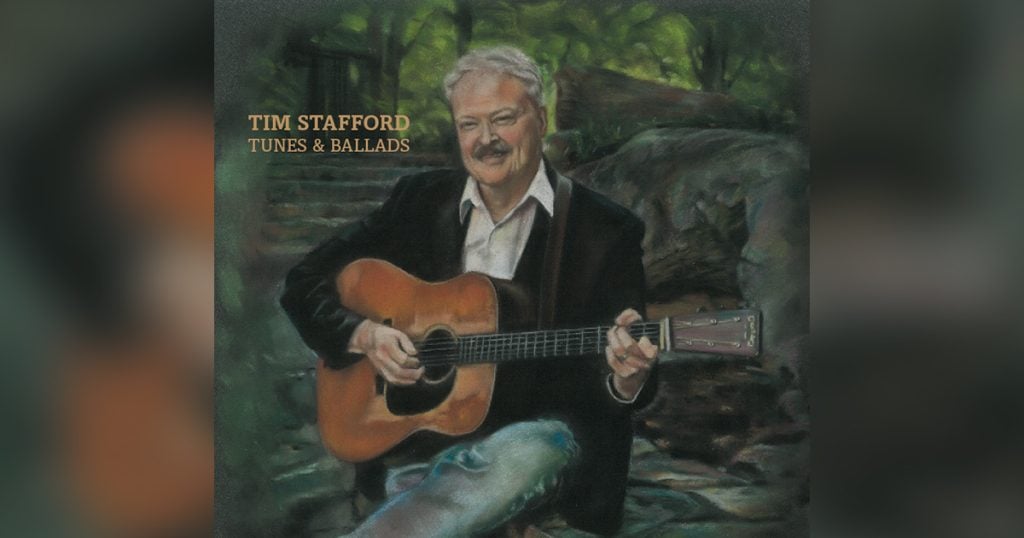Tunes & Ballads
Tim Stafford
On his latest solo CD, Tim Stafford artfully carries the listener from the redolent smells of greasepaint, bison sweat and saddle leather inside the big top tent of Buffalo Bill’s Wild West Show to the gruesome and much publicized serial murders in Victorian London’s Whitechapel District (which oddly are overlapping eras) in a bravura display of storytelling and musicianship that opens the mind as much as the ear. Stafford’s work and talents need no words of praise. His accomplishments would put three of him in the Bluegrass Hall of Fame in Owensboro. On Tunes & Ballads, his latest (almost) solo CD, Tim’s way with words and his under-appreciated gifts as a guitarist cross many musical boundaries and styles far beyond what his mainstream bluegrass band covers.
His fans know what to expect, and Tim delivers. If this is a new Tim Stafford CD, there must be historical ballads conveyed in his signature way of getting innately inside the characters he populates in his songs. We know these characters and feel their emotions through his words. We all know someone like “Ned Williams,” the aging brakeman in “The Last Clinchfield Run” who’s granted his unspoken request to engineer the steam locomotive once before they close the line for Number 9. You know his moistening eyes aren’t from coal smoke. Hell, we may even be Williams ourselves.
Always a fan of Tim’s singing, here it’s especially poignant as he vocalizes gracefully and delicately to give his melancholic tunes an achingly emotional vocal delivery. But as much as we all love Tim’s emotive tenor vocalizations, I did still find myself longing to hear Wayne Taylor’s blackened whiskey barrel baritone on a few tunes here.
As we’ve come to expect on these solo projects, Stafford delivers many great tunes. “The Marks,” co-written with Joe Newberry, takes the listener on the harsh trail of tears, microphone bumps and cigarette burns one very special old guitar has taken in life. “Arizona Tears” reflects the horror on December 7, 1941 with the entombment of 1,177 sailors who couldn’t escape the USS Arizona before she sank. Stafford wondrously instills these songs with people of real humanity and definition, turning three-minute folk tunes into 300-page novels with his plot and character development.
I once asked Tim, since he’s such a prolific writer, how he decided which of his originals were Blue Highway material and which were for his own use. His answer was that the songs basically sorted themselves out. “London Town” is exactly the kind of tune that wouldn’t work for Blue Highway, but fits here. It’s an elegant and haunting retelling of the sinister works of the Whitechapel serial killer known to most as Jack the Ripper—Saucy Jack to those in the know. The diabolical game the killer played with Scotland Yard made international news long before Clarice’s lamb fell silent. Tim’s guitar, touched by courage and resolve, tells the awful tale here as much as his voice.
The project’s instrumentals encompass serene solo guitar pieces like “Pale Blue Dot,” and the haunting fingerpicked “Coeburn Banner,” grounded by a killer “Red-Haired Boy” supercharged by a couple of clever key modulations and the mandolins of Jacob Burleson and Thomas Cassell. For all of us guitar geeks, Tim thoughtfully teases a list of the stellar new and vintage guitars he used on the project. A ’34 D-18. A ’43 Banner. His faithful Mario Proulx Dreadnought. Sure wish there’d been room for him to designate which guitar is on which track, but it’s always fun guessing. And special thanks to engineers Jim Price and Bobby Starnes who filled my headphones with a breathy, seductive, air-filled guitar sound across all 17 tunes.
Tunes & Ballads he names it, and that’s precisely what the CD delivers. Fans of Blue Highway and Tim’s earlier solo CDs will love it.
Share this article
1 Comment
Leave a Comment Cancel Reply
This site uses Akismet to reduce spam. Learn how your comment data is processed.


A clarification for anyone who cares. The Clinchfield Railroad ran its last steam engine in 1954, and was absorbed into what became CSX Transportation in 1983. So it was not a steam locomotive, and that is pretty clear when the engineer switches down from automatic to manual, something only possible in a diesel locomotive.